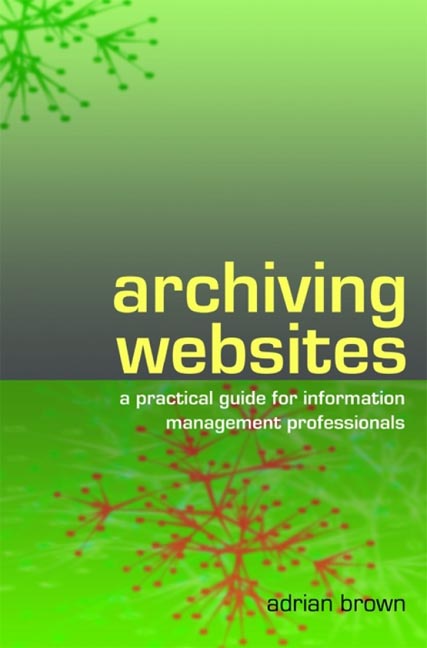Book contents
- Frontmatter
- Contents
- Acknowledgements
- Glossary
- 1 Introduction
- 2 The development of web archiving
- 3 Selection
- 4 Collection methods
- 5 Quality assurance and cataloguing
- 6 Preservation
- 7 Delivery to users
- 8 Legal issues
- 9 Managing a web archiving programme
- 10 Future trends
- Appendix 1 Web archiving and preservation tools
- Appendix 2 Model permissions form
- Appendix 3 Model test script
- Appendix 4 Model issues log
- Appendix 5 Model job description
- Bibliography
- Index
- Digital Preservation
- Frontmatter
- Contents
- Acknowledgements
- Glossary
- 1 Introduction
- 2 The development of web archiving
- 3 Selection
- 4 Collection methods
- 5 Quality assurance and cataloguing
- 6 Preservation
- 7 Delivery to users
- 8 Legal issues
- 9 Managing a web archiving programme
- 10 Future trends
- Appendix 1 Web archiving and preservation tools
- Appendix 2 Model permissions form
- Appendix 3 Model test script
- Appendix 4 Model issues log
- Appendix 5 Model job description
- Bibliography
- Index
- Digital Preservation
Summary
The world wide web is such a pervasive cultural phenomenon that it is easy to forget its relative infancy. Although the internet itself can trace its origins to ARPANET, the computer network developed by the US military in the late 1960s, the world wide web has a much more recent history. Its birth can, arguably, be assigned a very precise date: at 2:56:20 pm on 6 August 1991, the world's first website was made available on the public internet by Tim Berners-Lee at CERN, the European Organization for Nuclear Research. The privatization of the internet's backbone infrastructure in 1995 opened the door to commercialization, and its original academic and scientific usage was rapidly subsumed as public and commercial interest escalated. To describe its expansion, from that prototype system for information exchange within the high-energy physics community to the global information network of today, as dramatic is an understatement. By 2005, the public web was estimated to comprise over 11.5 billion web pages. And the public part of the web is the minority: the so-called ‘deep web’ – content which is inaccessible to search engines or to which access is controlled – is thought to be 500 times larger.
The technological development of the web has been equally remarkable. This can be illustrated graphically with examples of government websites taken from the collections of The National Archives of the UK. Figure 1.1 shows the home page of the Home Office website in 2000, and Figure 1.2 is taken from the same site in 2005.
The 2000 website, typically for its era, was primarily text-based, with only rudimentary graphical and design elements. Only five years later, the same site offers sophisticated graphics, intelligent searching, audio, video and animated content, and live news feeds. It is instructive and perhaps a little alarming to see how the technologies which, at the time, seemed exciting and innovative can, in such a brief period, come to appear so primitive.
During the course of this extraordinary growth, the web has evolved into perhaps the single most dominant communication channel in the world. The ‘Google generation’ not only search for information on the web, they also use it to shop, bank, watch television, chat to friends and family, book their holidays and play games.
- Type
- Chapter
- Information
- Archiving Websitesa practical guide for information management professionals, pp. 1 - 7Publisher: FacetPrint publication year: 2006



